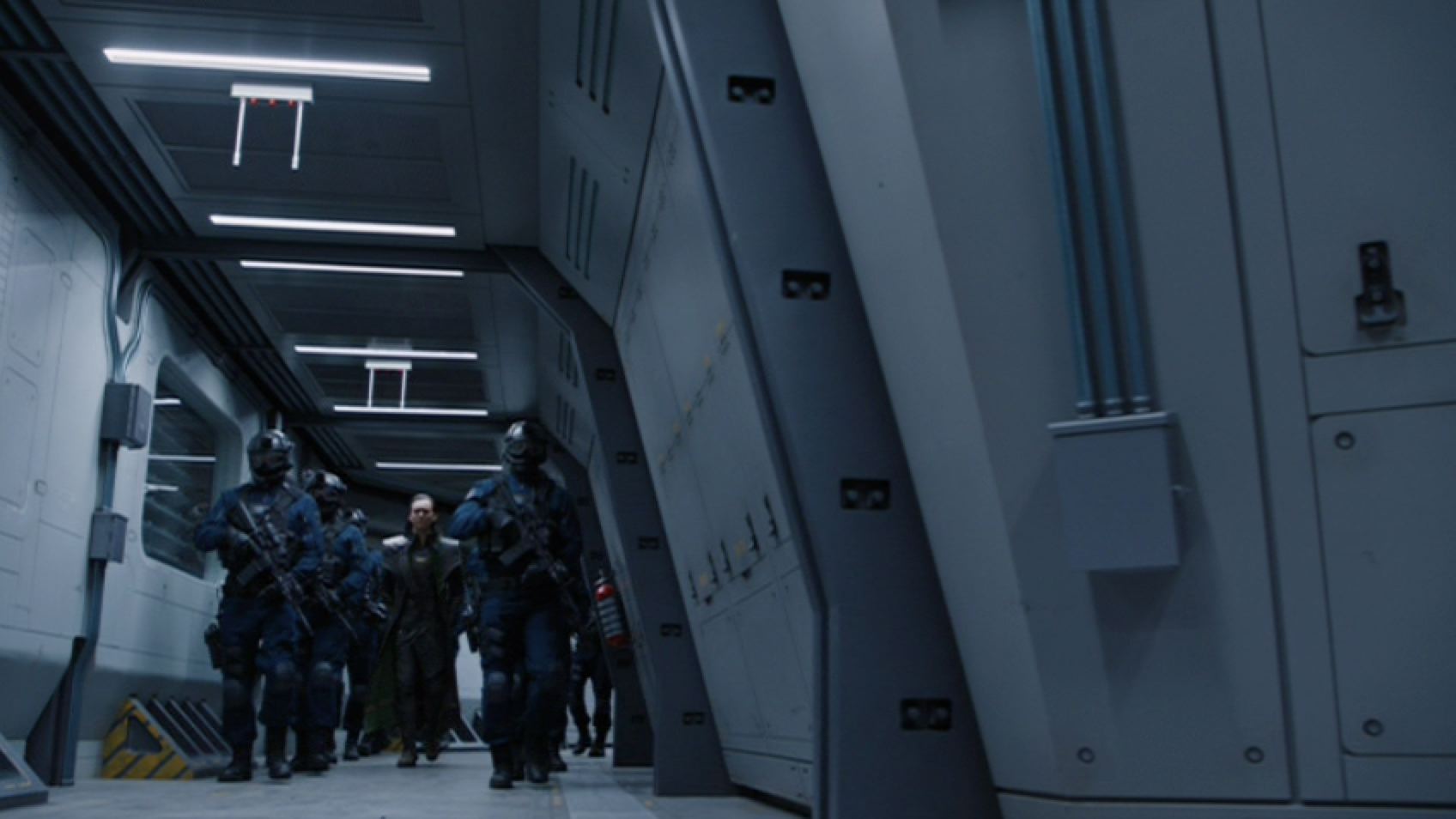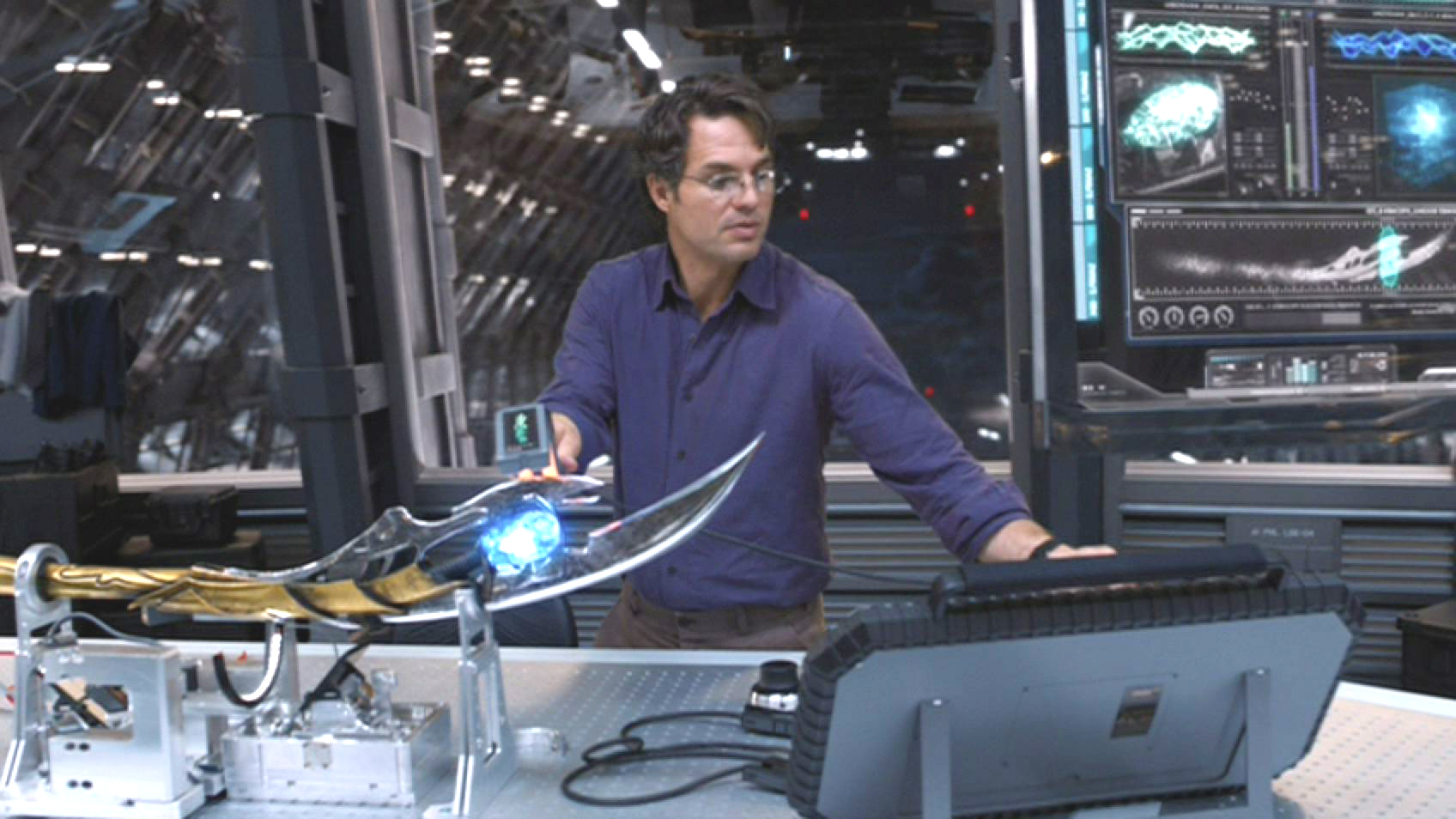The Avengers part 9
Loki, our chief antagonist so far, is aboard SHIELD’s helicarrier. The viewer is a little confused: one street fight in Stuttgart, and the bad guy is captured? Loki’s introductory shot, so reminiscent of Hannibal Lecter in Silence of the Lambs, was not a coincidence. Loki will go on to make the Lecter comparison concrete. Not only will he play the Lecter suit of corrupting minds from his cell, he is, like Lecter in Silence, not the real anatgonist, only the most charismatic one, the one most fun to watch.
Elsewhere on the helicarrier, Bruce Banner works at a high-tech machine of some kind, doing science stuff, as Loki is paraded by in cuffs. (How you cuff a Norse God, I’m still not clear on.) Loki gives Bruce a sly smile as he passes. He is a god of chaos, an expert in loss of control, the thing Bruce fears the most. Moreover, he is on his way to the helicarrier’s big-deal high-tech unbreakable prison cell, a cell designed to hold Bruce, should he ever hulk out.
Fury, playing Dr. Chilton to Loki’s Lecter, explains how the cage works: if Loki misbehaves, he gets dropped 30,000 feet to the ground. I’m not sure how that’s supposed to effect a Norse god, but I’ll take it on faith that it’s bad for him. Loki, undaunted, lectures Fury on the nature of the movie’s maguffin: the Tesseract is “Power” in its most plastic sense: it can light the world, or put it in the thrall of an oppressor.
Next, we have a powow scene between Bruce, Steve Rogers, Thor and Black Widow, discussing what to do next and catching the audience up. Ordinarily, I chafe at these kinds of expository scenes, and there are many of them in The Avengers, but this is the culmination of several scenes, played out piecemeal in Act I, the information finally strung together for the first time. The Avengers understands that it’s throwing a lot of sensation at its audience, a lot of characters, a lot of imagery and dialogue and conflicts and weirdness, so it’s been very careful to parcel out its exposition, so that the key components of the plot, “Tesseract,” “Loki,” “Chitauri,” “Portal,” “Army not of this world,” have been mentioned but not explicated until now. That strategy keeps this scene from being an info dump, and invites the viewer in, makes the audience one of the team.
Tony Stark and Coulson enter the meeting. Tony is caught in mid-sentence, murmuring something to Coulson about “flying him into Portland” to “keep love alive.” Again, off the cuff, personal, not related to the plot, barely heard, but a tiny little narrative time bomb to detonate later.
Tony catches the team up on iridium, which Dr. Selvig needs for the portal Loki is building to let the Chitauri through into our world. Tony shows off, playing the jerk to cover for his planting of a device on Fury’s bridge. Tony, like Robert Downey Jr.’s other big-ticket role Sherlock Holmes, uses his intelligence, callousness and cynicism to hold the world at arm’s length: if people dislike him they won’t want to be around him, and he’ll get to do his work. Which, the screenplay reminds us, he’s very good at: Iron Man is not merely a suit, but a genius asshole in a suit.
Tony and fellow-nerd Bruce head to the lab for some science. As you can see from the above still, “science,” here, involves pointing a price-scanner at a shiny stick and reciting a bunch of sciencey-sounding stuff. What is happening, dramatically, is that Tony and Bruce are bonding, the man who lives to keep tight control of himself and the man who lives to express his every whim.
Steve shows up, and he and Tony expand on their earlier conversation contrasting “good soldier” with “cynical bastard.” When pressed for an opinion on SHIELD, Bruce tries to retreat to a place of pure science (which connects him with Dr. Selvig, who loves the Tesseract for itself and not for its applications). He connects Fury’s desire for unlimited energy (or “power”) to Tony’s Stark Tower, which runs on an Arc Reactor, ie the same thing that runs his heart. The Tesseract, and Loki, and Fury, are thus elegantly tied to Tony and made his antagonists, which makes Tony an antagonist to our protagonsit Fury — Fury’s not going to have an easy time getting his super-family to work together if one of them suspects the father-figure of being dishonest.
Tony and Bruce then discuss their parallel super-powers. Tony’s engineering brilliance caused him to create the Arc Reactor, which not only saved his life but gave him his life’s work. Bruce, on the other hand, was given his powers through an accident and sees them as a curse, a terror to be avoided. We’ve seen the problems of Dr. Banner dramatised for decades now, but somehow the TV shows and movies never managed to get him this level of denial. Dread, yes, but not denial. Bruce in The Avengers isn’t just hoping that The Hulk doesn’t appear, he’s made it his business to pretend “the other guy” doesn’t exist. Tony, ever the hedonist, pushes Bruce to indulge his lust for power, which also ties him into the movie’s theme of power and its uses — in this case, power as a tool of self-actualization. Why be a brilliant scientist if you can also be a giant rage monster?



A flying fortress seems really impractical and vulnerable.
And cool.
Hmmm. I don’t think I agree that this version of Bruce Banner is pretending the other guy doesn’t exist. He never denies it, and in fact is hyper-aware of it at every moment; what he denies, I think, is ownership. It’s the other guy. He disassociates; he refuses to claim that power for his own — which is exactly what Stark is urging him to do.
One of the few weaknesses I see in this movie is that it doesn’t quite flesh out his arc enough to make me buy it, in between this point and him having control of it in New York. He says that his secret is he’s “always angry,” which is a nice line . . . but I’m not sure how it works, in terms of the arc. The phrasing it makes it sound like that’s been his secret all along, so what’s the epiphany that turns the other guy into an asset instead of a liability? I think it has to be acceptance — hinging around “son, you’ve got a condition” — but it’s left a bit too implicit for me to really get carried along.
The Banner/Hulk arc seems unclear/rushed. (It seems like the pivotal moment is when Harry Dean Stanton tells him that the other guy clearly has more on his mind than just destroying things, but as you point out, that great line about his secret doesn’t entirely fit.) Part of that confused arc might be the difficult previous versions of the Hulk. I mean, I saw The Incredible Hulk with Ed Norton, but I couldn’t tell you the first thing about it.
(Another line that I felt was strange was when Thor suddenly notes that the mass-murdering Loki is just adopted. It got a big laugh, but it didn’t feel super-fitted for the character.)
Thor’s “I’m saying a funny thing that’s not entirely in character” quip is to be expected of Whedon. I love most of Whedon’s stuff, but while he’s able to write different characters it sometimes seems he’s giving them all the same sense of humor. It’s more noticeable in longer series, like Buffy, where any character is capable of making the same joke any of the other characters (be they teen, adult, or thousand year old evilness) would make in any situation.
I’d say it’s not difficult to cuff a Norse God that wants to be cuffed…
The Hulk cage has always confused me. Because there’s no way they’re going to get the Hulk into that thing, the only chance is to get Bruce in there while he is Bruce. No power on that carrier (except maybe Loki) could wrangle Hulk into a little cage while he’s fully enraged. But they let Bruce walk around the carrier, barely even chaperoned, they even let people poke him with screwdrivers…
Not to mention, even if they did get the Hulk into the cage, after dropping the thing 30,000 feet to the ground it would just break apart and he’d be free. Hulk can survive that fall, as evidenced by him, well, surviving that fall after grappling with the fighter jet.
I suppose the point of the cage could just be to get the Hulk off of the carrier, but it still sets him loose on the populace below (unless they have the fortune of being over the ocean at the time of dropping the cage.)
The only situation where this might forseeably be used would be if Banner appeared to be in danger of Hulking out, but wasn’t actually doing so yet.
If that was the case, then I guess the Hulk-containment protocol would involve finding a non-populated area to hover over…
I’ve wondered how the Hulk landed in an abandoned NY warehouse after fighting that fighter jet, whereas everyone else had to fly for several minutes at least from the Helicarrier to the city.
Did he somehow fly the jet to NY and then fall off? Or did it explode and hurl him about (calculating guessing the nuclear missile traveled at mach 5 for 2.5 minutes) 32+ miles from the flying base? But then, Thor fell straight down and landed on a grassy coast, so who knows where the heck they were.
There’s nothing saying that either Thor or Hulk fly to New York. Thor lands on a beach, if I’m not mistaken, but Hulk could have flown anywhere on the eastern seaboard and still gotten to Manhattan in the time frame of the narrative.